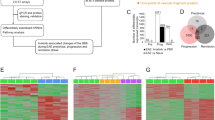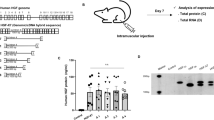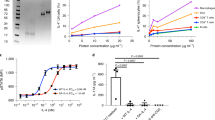Abstract
The development of therapies aimed to promote remyelination is a major issue in chronic inflammatory demyelinating disorders of the central nervous system (CNS) such as multiple sclerosis (MS), where the permanent neurological impairment is due to the axonal loss resulting from recurrent episodes of immune-mediated demyelination. Here, we show that the intrathecal injection of a herpes simplex virus (HSV) type-1 replication-defective multigene vector, engineered with the human fibroblast growth factor (FGF)-II gene (TH:bFGF vector), was able to significantly revert in C57BL/6 mice the clinicopathological signs of chronic experimental autoimmune encephalomyelitis (EAE), the animal model of MS. The treatment with the TH:bFGF vector was initiated within 1 week after the clinical onset of EAE and was effective throughout the whole follow-up period (ie 60 days). The disease-ameliorating effect in FGF-II-treated mice was associated with: (1) CNS production of FGF-II from vector-infected cells which were exclusively located around the CSF space (ependymal, choroidal and leptomeningeal cells); (2) significant decrease (P < 0.01) of the number of myelinotoxic cells (T cells and macrophages) both in the CNS parenchyma and in the leptomeningeal space; and (3) significant increase (P < 0.01) of the number of oligodendrocyte precursors and of myelin-forming oligodendrocytes in areas of demyelination and axonal loss. Our results indicate that CNS gene therapy using HSV-1-derived vector coding for neurotrophic factors (ie FGF-II) is a safe and non-toxic approach that might represent a potential useful ‘alternative’ tool for the future treatment of immune-mediated demyelinating diseases.
This is a preview of subscription content, access via your institution
Access options
Subscribe to this journal
Receive 12 print issues and online access
$259.00 per year
only $21.58 per issue
Buy this article
- Purchase on Springer Link
- Instant access to full article PDF
Prices may be subject to local taxes which are calculated during checkout





Similar content being viewed by others
References
Martino G, Hartung HP . Immunopathogenesis of multiple sclerosis: the role of T cells Curr Opin Neurol 1999 12: 309–321
Lucchinetti CF, Brück W, Rodriguez M, Lassmann H . Distinct patterns of multiple sclerosis pathology indicates heterogeneity on pathogenesis Brain Pathol 1996 6: 269–274
Kieseier BC et al. Effector pathways in immune mediated central nervous system demyelination Curr Opin Neurol 1999 12: 323–336
Prineas JW et al. Multiple sclerosis. Pathology of recurrent lesions Brain 1993 116: 681–693
Martino G et al. Cytokine gene therapy of autoimmune demyelination revisited using herpes simplex virus type-1-derivedvectors Gene Therapy 2000 7: 1087–1093
Furlan R et al. Central nervous system delivery of interleukin-4 by a non-replicative herpes simplex type 1 viral vector ameliorates autoimmune demyelination Hum Gene Ther 1998 9: 2605–2617
Furlan R et al. Central nervous system gene therapy with interleukin-4 inhibits progression of ongoing relapsing-remitting autoimmune encephalomyelitis in Biozzi AB/H mice Gene Therapy 2001 8: 13–19
Poliani PL et al. Delivery of a non-replicative herpes simplex type-1 vector engineered with the IL-4 gene to the central nervous system protects rhesus monkeys from hyperacute autoimmune encephalomyelitis Hum Gene Ther 2001 12: 905–920
Franklin RJ, Blakemore WF . Transplanting oligodendrocyte progenitors into the adult CNS J Anat 1997 190: 23–33
Scolding N . Therapeutic strategies in multiple sclerosis. II. Long-term repair Philos T Roy Soc B 1999 354: 1711–1720
Li Y, Field PM, Raisman G . Repair of adult rat corticospinal tract by transplants of olfactory ensheathing cells Science 1997 277: 2000–2002
Villoslada P et al. Human nerve growth factor protects common marmosets against autoimmune encephalomyelitis by switching the balance of T helper cell type 1 and 2 cytokines within the central nervous system J Exp Med 2000 191: 1799–1806
Chen LZ et al. Gene therapy in allergic encephalomyelitis using myelin basic protein-specific T cells engineered to express latent transforming growth factor-beta1 Proc Natl Acad Sci USA 1998 95: 12516–12521
Croxford JL et al. Cytokine gene therapy in experimental allergic encephalomyelitis by injection of plasmid DNA-cationic liposome complex into the central nervous system J Immunol 1997 160: 5181–5187
Leist T et al. A pilot study of recombinant insulin-like growth factor-1 (RHIGF-1) in seven multiple sclerosis patients J Neurol 2000 247: (Suppl. 3) III/22 (Abstr.)
Calabresi PA et al. Phase 1 trial of transforming growth factor beta 2 in chronic progressive MS Neurology 1998 51: 289–292
Krisky DM et al. Development of herpes simplex virus replication-defective multigene vectors for combination gene therapy applications Gene Therapy 1998 5: 1517–1530
Marconi P et al. Replication-defective herpes simplex virus vectors for neurotrophic factor gene transfer in vitro and in vivo Gene Therapy 1999 6: 904–912
Goddard DR, Berry M, Butt AM . In vivo actions of fibroblast growth factor-2 and insulin-like growth factor-I on oligodendrocyte development and myelination in the central nervous system J Neurosci Res 1999 57: 74–85
Blakemore WF, Keirstead HS . The origin of remyelinating cells in the central nervous system J Neuroimmunol 1999 98: 69–76
Gensert JM, Goldman JE . Endogenous progenitors remyelinate demyelinated axons in the adult CNS Neuron 1997 19: 197–203
Wolswijk G, Riddle PN, Noble M . Co-existence of perinatal and adult forms of a glial progenitor cell during development of the rat optic nerve Development 1990 109: 691–698
Prineas JW et al. Multiple sclerosis: oligodendrocyte proliferation and differentiation in fresh lesions Lab Invest 1989 61: 489–503
Franklin RJ, Gilson JM, Blakemore WF . Local recruitment of remyelinating cells in the repair of demyelination in the central nervous system J Neurosci Res 1997 50: 337–344
Lucchinetti C et al. A quantitative analysis of oligodendrocytes in multiple sclerosis lesions. A study of 113 cases Brain 1999 12: 2279–2295
Wolswijk G, Noble M . Cooperation between PDGF and FGF converts slowly dividing O-2A adult progenitor cells to rapidly dividing cells with characteristics of O-2A perinatal progenitor cells J Cell Biol 1992 118: 889–900
Mikecz K, Brennan FR, Kin JH, Glant TT . Anti-CD44 treatment abrogates tissue oedema and leukocyte infiltration in murine arthritis Nat Med 1995 1: 558–563
Jones M, Tussey L, Athanasou N, Jackson DG . Heparan sulfate proteoglycan isoforms of the CD44 hyaluronan receptor induced in human inflammatory macrophages can function as paracrine regulators of fibroblast growth factor action J Biol Chem 2000 275: 7964–7974
Mendel I, Kerlero de Rosbo N, Ben-Nun A . A myelin oligodendrocyte glycoprotein peptide induces typical chronic experimental autoimmune encephalomyelitis in H-2b mice: fine specificity and T cell receptor V beta expression of encephalitogenic T cells Eur J Immunol 1995 25: 1951–1959
Breitschopf H et al. In situ hybridization with digoxigenin-labeled probes: sensitive and reliable detection method applied to myelinating rat brain Acta Neuropathol 1992 84: 581–587
Acknowledgements
This work was in part supported by Telethon (Italy), Italian Multiple Sclerosis Society (AISM), IRCCS (Progetti Finalizzati) and Armenise-Harvard Foundation.
Author information
Authors and Affiliations
Rights and permissions
About this article
Cite this article
Ruffini, F., Furlan, R., Poliani, P. et al. Fibroblast growth factor-II gene therapy reverts the clinical course and the pathological signs of chronic experimental autoimmune encephalomyelitis in C57BL/6 mice. Gene Ther 8, 1207–1213 (2001). https://doi.org/10.1038/sj.gt.3301523
Received:
Accepted:
Published:
Issue Date:
DOI: https://doi.org/10.1038/sj.gt.3301523
Keywords
This article is cited by
-
Fibroblast Growth Factor Signalling in the Diseased Nervous System
Molecular Neurobiology (2021)
-
Polarizing receptor activation dissociates fibroblast growth factor 2 mediated inhibition of myelination from its neuroprotective potential
Acta Neuropathologica Communications (2019)
-
Fibroblast Growth Factor-2 Signaling in Neurogenesis and Neurodegeneration
Journal of Neuroimmune Pharmacology (2014)
-
Regulation of oligodendrocyte precursor migration during development, in adulthood and in pathology
Cellular and Molecular Life Sciences (2013)
-
Neurovascular signalling defects in neurodegeneration
Nature Reviews Neuroscience (2008)



